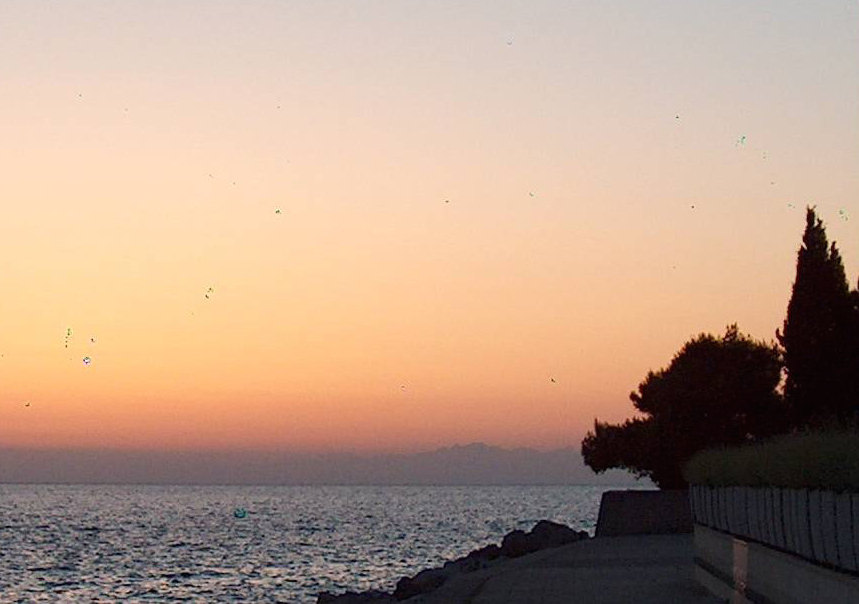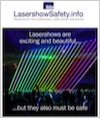Laser show damage to cameras
Lasers emit concentrated beams of light, which can heat up sensitive surfaces (like the eye's retina) and cause damage. Camera sensors are, in general, more susceptible to damage than the human eye.
For large scale shows, such as on a televised concert, laser show producers work with clients to avoid TV camera locations and video projectors (ILDA Members, see this page for details). However, it is not possible for laser show producers to be responsible for all cameras and camcorders which might be at a show.
Therefore, if you attend a show as an audience member, you should take reasonable precautions not to let a laser beam DIRECTLY enter your camera lens.
• You can photograph the beams in midair, or doing graphics on a screen. If you can't see the laser source (projector output aperture or bounce mirror) in your viewfinder, this means you're not getting the full beam power into your lens. Indirect viewing like this should not cause damage.
• Avoid beams which are coming straight onto your lens. The damage potential is much greater when the entire beam power enters the camera lens.
Eye safety is primary
The primary safety concern for laserists is that the show is eye-safe. A good working definition of "eye-safe" is that everyone leaves the show with the same vision they entered -- there is no detrimental change to a person's vision.
International safety standards such as IEC 60825 and ANSI Z136 set "Maximum Permissible Exposure" levels for laser light. Shows done at or below the MPE should cause no problem for human eyes.
Even shows which exceed the MPE have remarkably safe records (eight documented or claimed eye injuries out of 109,000,000 persons viewing continuous-wave laser shows over 30 years).
However, there are no MPEs for sensors such as CMOS or CCD chips. This means a show may be perfectly safe for eyes, but could possibly damage a camera sensor. One reason is that camera lenses may gather more laser light, and concentrate it to a finer point. Another reason is that a CMOS or CCD sensor may be more easily damaged than the eye.
Due to the many varying factors involved with lenses and sensors, laser show producers cannot be responsible for audience-member damage to cameras or camcorders.
SLR camera and binoculars warning
Photographers who use an SLR or DSLR camera should not look through the viewfinder directly towards the laser projector output.
The camera lens will gather much more light than the human eye. This is focused by the mirror in an SLR or DSLR camera into the viewfinder, thus increasing the amount of laser light. (This is not the case for any camera or camcorder where a person views the image on a screen.)
Similarly, persons should not use binoculars, a telescope or similar optical light-gathering devices to view audience scanning lasers.
Types of damage
The severity of damage can vary widely.
• We have seen cases of minor damage, such as small areas of a few pixels which no longer work. The pixels are not noticeable unless in an area of uniform color such as a blue sky.
• In more extreme cases, there may be larger or more extensive dead-pixel areas. Or there may be "burn in" of a laser image. The damage is readily noticeable in most photos or videos. In this case, the camera is ruined for quality use.
This photo shows numerous laser-caused spots on an HP Photosmart 945. Click for a larger view. (Photo courtesy Aljaž Ogrin.)
Damage to one location may result in a horizontal or vertical line. In such a case, data from the entire row or column of sensors can no longer be read out properly.
Search YouTube and other internet sources for videos and pictures of laser-caused damage. See for example Laser light kills Canon 5D Mark II, or Lasers killed my CMOS.
Note that not all claims of laser damage are valid. In March 2009, we reviewed a case where it was claimed that a Fuji F60fd 12-megapixel point-and-shoot camera was severely damaged by a laser. ILDA analyzed video from the camera, and determined the probable cause to be a very bright white light.
In another case, this YouTube video shows a standard camera flash (speedlight) causing severe damage to a CCD sensor in an instant.
For more information
A webpage called “Analysis of Laser Light Threat to CCTV” gives a good general overview of what power ranges and usage patterns might damage camera sensors.
Sacha Casken's Masters thesis describes laboratory experiments on how consumer point-and-shoot cameras were damaged by blue, green, and red laser beams. An excerpt from his thesis is here.
A March 2017 article in the journal Optical Engineering looked at laser damage to CMOS and CCD sensors, and to digital micromirror devices (DMDs) used in video projectors. A summary is below (blue button) of the damage threshold to these sensors and devices.
More information on laser eye safety
ILDA has presented information about audience-scanning laser shows in the scientific paper "Scanning Audiences at Laser Shows: Theory, Practice and a Proposal". This gives some reasons why even shows which are well above the MPE have not caused any apparent eye changes in millions of audience members. Some of the reasons may also be relevant to why some camera sensors are damaged while many others are not.
More information for Members
ILDA Members can get more specific information on avoiding camera and video projector damage, on this page (password required).
More information on protecting cameras (for producers)
A producer asked ILDA if there were any filters available that fit camera lenses, to help protect them from laser light. See the reply below.
Also below is brief information on a line of Epson video projectors that includes a mechanical shutter to protect the lens from laser damage.
-
Can a filter protect cameras?
The following was written in response to a video producer who wanted to know if there was a filter that could protect cameras from laser light.
We are not aware of any such special lens filters made specifically for cameras, that will protect a sensor from laser damage.
There are filters for camera lenses which can reduce the total amount of light coming in. In other words, the filters darken the entire scene. Such Neutral Density or ND filters are widely available. Unfortunately, no one can say without testing how strong an ND filter is needed to stop a particular laser from causing damage to a particular sensor.
For example, ND2 will reduce the light to 50% (half) of its normal intensity. An ND8 filter will reduce it to 12.5% (1/8) of its normal intensity. An ND8 filter may help, but with a powerful laser and a long enough exposure, even ND8 may not be sufficient. (A direct laser beam can also damage or burn through a ND filter, since it absorbs light.)
It is possible to purchase glasses, goggles, and sheets of plastic or glass that can protect against laser light. The manufacturer would need to know what specific wavelengths of laser light are being used, and at what power, in order to provide adequate defense against the laser.
If the laser is green only, then the protective material would block green light of that wavelength. This will distort the colors seen by the camera -- green will be reduced. A very high quality filter can knock out only the exact laser wavelength, allowing some green to be seen, but such a narrow-band filter is more expensive.
If the laser is multi-colored, then the filter must block red, green and blue laser wavelengths. Obviously, this affects many more colors than just a green-only filter. It is even more expensive.
Finally, it still is necessary to know how much the laser light needs to be reduced (how much ND) in order to protect the sensor. Without testing the laser and the sensor (e.g., knowing how much laser light damages your sensor), this is just a guess.
My recommendation is to simply make sure that no direct laser beams go into the camera lens, or close to the camera lens (within an inch or two at closest). It is the direct laser beams that will cause sensor damage, although damage is also possible if the camera is looking at the laser "dot" or a laser drawing on a surface and the dot or drawing is very bright.
Keep in mind that accidents can happen. In one situation, 12 expensive (>$100,000) Barco projectors were on truss. The laser operator set the beams during rehearsal so they missed the Barco projectors. But during the show, the truss operator did not lift the projectors to the rehearsal height. All 12 Barco projectors were damaged, through no fault of the laser operator.
You may want to consider using less expensive cameras for shots where the beams are coming towards the camera. You may also want to discuss with the laser operator who will be responsible for sensor damage if it occurs. For example, if your cameras are at fixed heights on tripods, then the laser operator would be responsible for keeping the beams so they cannot enter the camera lens. But if the cameras are moving, then it becomes the camera operator's responsibility to not be in a known laser beam area.-
Projectors with built-in laser protection
- In early 2019, Epson introduced two projectors that have a mechanical shutter "to protect the lens from laser damage."
These are the models EB-L12000Q and EB-L20000U. Ironically, these use lasers as the light source for the projector.
There may be other models, from other manufacturers, but these two Epson models are the first we are aware of.
From WorshipAVL and The Jakarta Post -
Damage thresholds of CMOS, CCD and DMD devices
- A March 2017 article in the journal Optical Engineering looked at laser damage to CMOS and CCD sensors, and to digital micromirror devices (DMDs) used in video projectors. The authors looked at both pulsed lasers and continuous wave lasers. Since CW lasers are used in audience-scanning laser shows, we are presenting only the CW laser beam results.
This graph shows that damage to a color CMOS sensor starts at around 40,000 to 60,000 watts per square centimeter for an exposure of 0.25 seconds: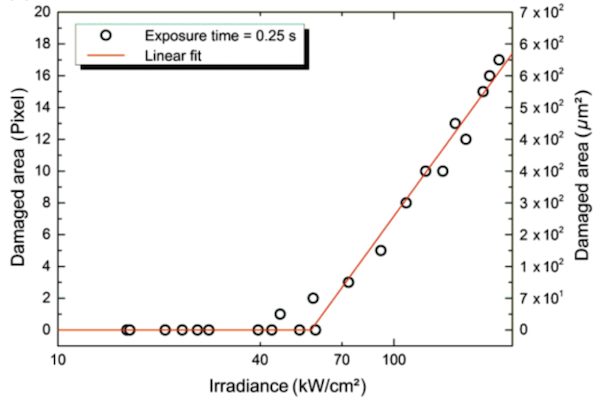
However, a color CCD sensor is more vulnerable. Damage begins to occur at around 16,000 W/cm2 for 0.25 and 0.1 second exposures (black and red lines) and at around 9,000 W/cm2 for exposures of 5 and 10 seconds (blue and green lines):
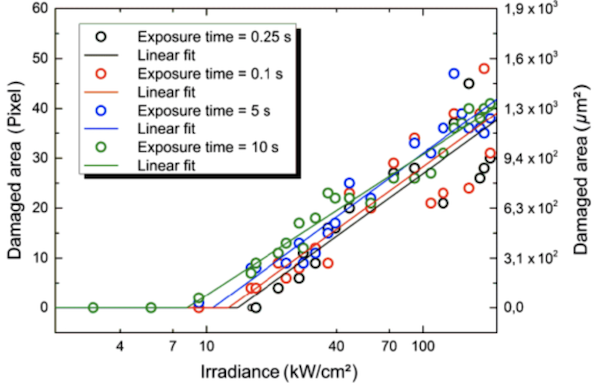
Incidentally, the authors found that a digital micromirror device (DMD) commonly used in video projectors had a damage threshold of about 19,000 W/cm2.
For comparison, a 5 mW laser pointer at a 1 foot distance has an irradiance of 0.374 W/cm2. After magnification by the lens of the eye, the same laser’s irradiance on the retina is 440 W/cm2.
So, assuming a camera has a lens with similar magnification as the eye's lens, an irradiance of 440 W/cm2 is well below the damage threshold of 40,000 W/cm2 for a CMOS sensor or 16,000 W/cm2 for a CCD sensor. (This assumption may not hold since camera sensors have been known to be damaged by relatively low powered lasers aimed directly into the lens.)
Jan 14 2019: Corrected CMOS text description which was previously off by a factor of 1000. Thanks to Dominik Jančik for pointing this out. -
Are tattoo lasers similar to laser show lasers?
- No, tattoo lasers are pulsed while most laser show lasers — and all of those used in regulated audience scanning — are continuous wave lasers.
In March 2019, a video showed laser tattoo removal damaging a high-end digital camera sensor just by taking a video of the laser pulses on the skin.
The laser beam did NOT directly enter the Sony A7SII lens. And yet with every tattoo removal pulse of the green laser, the camera sensor was obviously damaged. According to the person posting the video, "The repair cost was about as much as a new camera [about $2200] so try to avoid this."
If a laser is powerful enough, just looking at the dot of the laser on a wall can be a "diffuse reflectance hazard." In this case, the reflected laser light was powerful enough to damage the sensor.
This is not a flaw in the laser or the camera. As described elsewhere, camera sensors are generally more sensitive than the eye. Also as noted, different cameras may have different sensitivities depending on many factors.
For example, this page includes four YouTube videos showing laser tattoo removal, without any apparent damage to the video sensor.Laser show lasers vs. tattoo removal lasers
For laser light shows, pulsed lasers like those used for tattoo removal should never be aimed at an audience, because the peak power (pulse) is so strong it can cause immediate eye damage.
Instead, laser light shows use continuous wave lasers. As the name implies, these have a steady beam and in general are safer to the eye. (CW lasers damage the retina by heating it up; pulsed lasers create an "acoustic shockwave" which instantly causes a popcorn-like explosion in the retina.)Tattoo laser details
According to this page, a typical tattoo removal laser has a maximum pulse energy of about 1-2 Joules and a pulse width of about 5-10 nanoseconds. It is not known how powerful the laser was in the video.
Everyone in the room should have been wearing laser safety glasses or goggles that reduce the laser light to safe levels. If the camera had been shooting through the safety glasses' lens, the damage likely would not have occurred.
-
Are lidar lasers similar to laser show lasers?
- No, lidar lasers — at least those used in autonomous self-driving vehicles — emit non-visible laser beams which are at a wavelength and power level considered safe for human eyes. This is of course different from the visible laser beams used at a laser show.
In early January 2019, a man attending the CES technology show in Las Vegas claimed his Sony A7RII camera's sensor was damaged by the lidar from a company called AEye.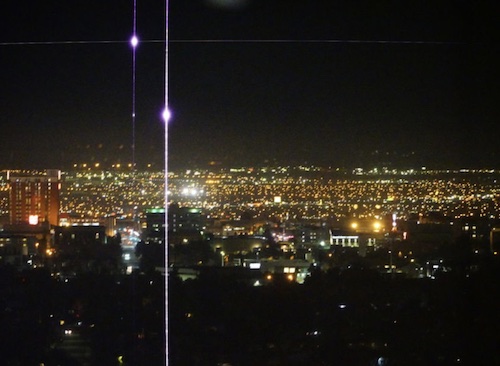
More on the claim, and links to lidar information, is here.
-
Surveillance camera damage from laser pointers
- IPVM, a research group focusing on surveillance cameras, tested different powers of lasers being used against three types of security cameras, from various distances.
The researchers' found it was easy to temporarily "blind" a camera since the bright laser light overwhelms the sensor's view. But it was difficult to keep the laser steady on the sensor.
In a YouTube video they said "It is very difficult for a human to train a laser on an object from roughly five feet away and further without their hands shaking off target. We found that using a clamp to clamp the laser steady to a stationary object to be the best means of consistently blinding a camera from roughly 50 feet away or further."
In terms of causing permanent damage to sensor pixels, to the whole sensor or to the lens, IPVM summarized as follows:- "Close range required: Permanent damage did not occur from distance of ~50 feet or further from the camera, regardless of the strength of the laser we tested."
- "Aiming by hand difficult: Targeting a laser towards a camera is difficult from more than ~10' away. Attaching the laser to a stationary object for aiming makes sensor damage much more likely."
Lasers used included low-powered laser pointers in the 5 milliwatt range (legal for sale in the U.S. as laser pointers) and high-powered handheld lasers. The group said the two high-powered lasers were around 30,000 mW (30 watts) but that is extremely unlikely. They probably were closer to 3,000 mW (3 watts).
The security camera sensors could be damaged at various powers and distances. But IPVM found it was much more difficult to cause permanent damage that rendered the cameras completely useless for surveillance purposes.
For more details, see the September 25, 2019 IPVM report "Lasers Impact on Surveillance Cameras Tested."
For more information, visit our other ILDA websites:
© 2007-2025 International Laser Display Association. All rights reserved.
Contact ILDA
No reproduction of the text or images on ILDA websites is allowed without written permission of ILDA or other copyright holders. "ILDA" and the ILDA logo are trademarks of the International Laser Display Association.
This site does not use cookies and does not track or gather information on individual visitors. Aggregate information is gathered by Google Analytics to determine overall visitor behavior. More information is on our Privacy Policy page.

